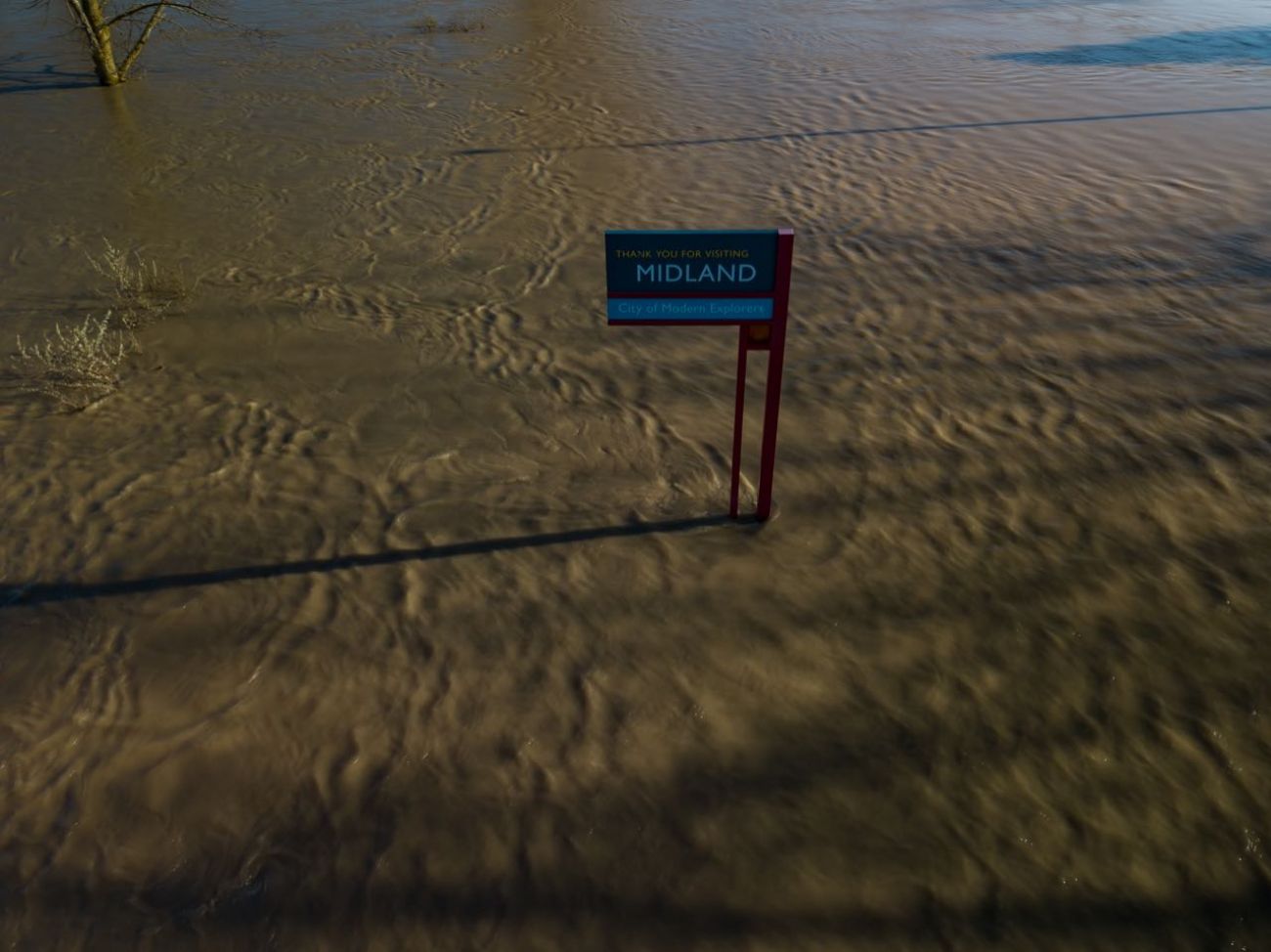Two heirs bought Midland dams as a tax shelter. Tragedy followed.

In 2006, the clock was bearing down on Lee Mueller’s family.
Heirs of the founder of the Boy Scouts of America, Mueller and his relatives needed to reinvest money from the sale of an Illinois property in less than a year — or pay $600,000 in taxes to the IRS.
Eventually, a solution came to Mueller, an architect who lives in Las Vegas, and his cousin, Michel d’Avenas, a California musician who is the son of a French count and is now known as the Pebble Beach Bagpiper.
They would avoid taxes by purchasing four small hydroelectric dams in mid-Michigan near Midland, according to hundreds of pages of federal court records reviewed by Bridge.
The deal was troubled from the start for trustees of the William D. Boyce Trusts, which manages the fortune of a Chicago publishing magnate who founded the Scouts at the dawn of the 20th century. In the 14 years that have followed, Mueller and the trust have clashed repeatedly with state officials, federal regulators, local homeowners and even fishermen.

The source of friction: money, according to neighbors and court records.
Mueller “hates government, he hates paying taxes, and nothing makes him happier than when he can stick his finger in the eye of government,” said Joe Manelis, a longtime Sanford Lake homeowner who has clashed with Mueller over one of the dams on his lake.
Last week, after Boyce Hydro Power LLC, as well as prior owners, failed for decades to heed demands of federal regulators to increase flood capacity at the largest of the four dams, the Edenville Dam failed, sending billions of gallons downstream, destroying homes, property and prompting the evacuation of some 10,000 residents of Midland, Gladwin and Saginaw counties.
- Related: Gov. Gretchen Whitmer launches investigation into Midland dam failures
- Related: Mid-Michigan dam that failed was cited for years for safety violations
- Related: Michigan regulators moved fast on dangerous dam. To protect mussels.
- Relate: Michigan GOP calls for Nessel to step down from investigation into dam failure
The flood came 1½ years after federal regulators terminated Boyce Hydro’s license to generate power at the Edenville Dam, citing decades of failures to fix spillways that can prevent flooding.
Mueller’s attorney, Lawrence Kogan of New York, said his client wanted to make repairs but didn’t have the money. Mueller is devastated by the flood, Kogan said.
“Of course, the man hasn’t slept,” Kogan said. “He feels terrible about all this.”
Court papers indicate the Boyce Trust said the dams have lost money every year since at least 2016.
Residents who live on lakes surrounding the dams are dubious about the pleas of poverty and accuse Mueller and the Boyce Trust of being absentee owners who for years didn’t invest in repairs.
“He was a ‘teller’ and a ‘seller,’” said Jan Colton, a Wixom Lake resident, adding that Mueller tells people what to do and sells them on the idea that they should pay for it.
‘He keeps us all in the dark’
Money used to buy the Midland dams came not from Mueller nor d’Avenas, but from trusts set up in the 1920s by their multimillionaire ancestor.
William D. Boyce was a tycoon who made his fortune on local newspapers and had a soft spot for adventure and progressive causes like labor unions. He later founded the Boy Scouts of America, now known as Scouts BSA, whose mission is to prepare youths to “make ethical and moral choices over their lifetimes.”
When he died in 1929, Boyce’s estate was worth $20 million, according to one biography, the equivalent of $300 million today. It was divided into a series of trusts that descendents Mueller and d’Avenas eventually led.
Mueller, described in press reports as a grandson, backs conservative causes and once listed his occupation in a campaign donation as a “spark of freedom.” D’Avenas is a great-grandson whose father was a French royal. He split his time as a child between France and Carmel, California, in a beachfront home later bought by actor Gene Hackman.
“I’m just a plain old count. I don’t take too much stock in that stuff,” d’Avenas told Bridge.

By 2005, when Mueller and d’Avenas controlled the trust, they found themselves in a time crunch.
That September, Boyce Trusts sold a property in Illinois with the intention of buying a new one to avoid paying taxes on the sale, according to a lawsuit Mueller and d’Avenas filed in 2007.
Under federal tax code, owners of investment properties can defer paying capital gains tax on their properties when they sell them if they buy similar ones in a certain period.
The cousins had 45 days to find alternative sites and six months to buy one, or they risked having to pay more than $600,000 in capital gains taxes. Mueller and his associates identified the four Midland dams and buildings in Indianapolis and Houston as options, and bought the dams in 2006 after borrowing money to complete the purchase.
Mueller “spearheaded using the trust money to go after the dams in Michigan,” d’Avenas told Bridge.
D’Avenas described himself as a hands-off trustee who left daily operations to his cousin Mueller and resigned from the trust a few years after the sale.
A fixture in Monterey Bay, California, d’Avenas has been a professional bagpiper for more than 40 years and told Bridge he lost track of the Boyce family interests years ago.
He said he didn’t know about the floods until a Bridge reporter told him of them Tuesday night.
Mueller “doesn’t tell us anything. He keeps us all in the dark. … I don’t know what to say. I guess I can understand why he kept us all in the dark,” d’Avenas said.
“He was responsible for all of that.”
The purchase of the dams for $4.8 million prompted a mess of litigation that began just before the deal was finalized.
On almost the last day before the tax deadline, the two men who helped broker the deal added new stipulations, the Boyce Trusts allege in court records.
Because the trusts could not afford the entire purchase price, they borrowed about half from a California man, R.L. Milsner, who then sought payments of $150,000 a year until the loan was repaid, records show.
Another man, Scott Goodwin, who was hired as co-manager of the dams, got provisions giving him substantial control of the companies. Goodwin, who had run other hydroelectric dams, helped persuade Mueller to buy the mid-Michigan properties in the first place, according to the 2007 lawsuit.
The relationship between the trusts and Milsner and Goodwin deteriorated quickly, with accusations between the sides that spilled into lawsuits in Gladwin County and federal court. The trusts also battled the law firm that negotiated the deal in court for nearly a decade over legal fees.
D’Avenas resigned from the trust a few years after the sale.
“I just said I’m tired of this stuff,” said d’Avenas, who declined to elaborate.
“So then someone else is gonna do it. I just didn’t want to do it anymore.”

Problematic dams
The dams came with their own challenges.
Since 1993, the Federal Energy Regulatory Commission had told Boyce and previous owners that Edenville Dam didn’t meet design standards and was in danger of failing during a heavy rainstorm.
FERC found the dam could drain only about half of expected “probable maximum flood,” — the amount of water expected only in the most severe weather — but the agency’s regulations require it to be able to pass the full maximum flood.
FERC directed Boyce to build new spillways that could accommodate worse flooding, but for more than a decade, Boyce failed to complete the project and claimed it lacked the money to do so.
In a June 2017 compliance order, FERC commissioners warned that failing to fix the spillways could endanger human life. The company’s “disregard for the severity of this situation is appalling,” the commissioners wrote.
In 2018, FERC revoked Boyce’s license to generate power at Edenville.
Kogan, Boyce’s attorney, pointed out that FERC had asked two previous owners to also add extra spillway capacity.
“And none of them were able to do it,” Kogan said Tuesday. “You cannot look at the economics of this in a vacuum.”
The Edenville dam generated about $1 million in annual revenue, according to court papers, while three smaller ones nearby generated another $900,000. Expenses were $1.2 million or less, records show.
Boyce Hydro has lost $6,000 a day since the license was revoked, according to court papers.
In court papers, the company wrote it planned to put revenue from the Edenville Dam in an escrow account to finance the spillway improvements.
“The absurdity of the requirement that … [Boyce Hydro] cease generating electricity at Edenville is that the same water that would be used to generate electricity must instead be wasted over the spillway for reasons having nothing to do with dam safety,” according to a federal suit opposing the revocation.
“The sustained cessation of generation … in the long term will increase the potential for flood damage.”
Many run-ins
Although he lived in Nevada, Mueller made his presence known in Michigan, often feuding with cottages along Wixom and Sanford lakes over water levels.
In 2013, local television stations reported that he faced charges on claims of ramming his car into a pick-up truck filled with people who had parked on his property to fish.
The next year, he was accused of using a heavy chain to smash in the car windows of two others who fished by the dam.
Both cases were charged as felonies and reportedly pleaded down to misdemeanors, according to news reports.
Mueller and Boyce also clashed with state regulators who demanded he improve recreation opportunities near his dams, according to court records and lawsuits.
As part of license agreements, the companies were supposed to build a recreation area including a parking lot, fishing pier, canoe portages and access paths.
By 2015, state inspectors found Boyce Hydro not only hadn’t followed the agreed-upon plan, the company had set up fencing and barbed wire to prevent public access, records show.
Two years later, the Michigan Department of Natural Resources determined access was still limited.
Boyce Hydro also fell behind on property taxes on land underlying Sanford Lake, a 1,489-acre reservoir behind Sanford Dam that is among the four Michigan dam properties Boyce Hydro purchased in 2006.
By the time Midland County foreclosed on the Sanford lakebottom properties in March 2010, Mueller’s company had racked up more than $30,000 in unpaid taxes, according to news reports from that time. In total, the county foreclosed on 27 parcels.
Mueller said at the time he had intentionally not paid his taxes, telling MLive the county’s property records were “greatly and massively flawed.”
Kogan contended the dams never earned enough from selling electricity to Consumers Power to cover all the expenses, including the Sanford Lake upgrades, taxes and the major repairs needed at Edenville.

Private owners, public trouble
Boyce Hydro’s clashes with government authorities and nearby communities highlight one of the liabilities of owning critical infrastructure as a private investment, said Jeremy Bricker, a civil engineering professor at the University of Michigan and Delft University of Technology in the Netherlands.
There are almost 2,600 dams in Michigan, about three-quarters of which are privately owned, according to the American Society of Civil Engineers.
When the country’s old hydroelectric dams were first built, they required little maintenance and generated sizable profits, Bricker said.
But as those dams have aged, their maintenance needs have increased while profits from selling electricity have decreased.
If private owners are unwilling or unable to conduct needed repair and maintenance, as Bricker said “is probably going to be the case with many dams,” the public bears the risk of the owner’s disinvestment.
That’s what happened at Sanford Lake.
Losing the lakebottom to foreclosure created a new problem for Mueller. The Sanford Dam’s FERC license required the company to control the bottomlands.
In April 2010, FERC sent Mueller a letter threatening fines and possible license revocation if he failed to regain control of the properties, either by purchasing them back or obtaining an easement to use them.
The letter prompted years of wrangling between Boyce, Midland County and lakeshore residents as they sought a solution to the bottomlands issue.
Meanwhile, new conflicts arose between Mueller and area landowners.
In August 2010, Boyce began draining the lake to conduct dam repairs without first warning lakefront homeowners, said Manelis, the property owner.
Homeowners had to scramble to remove boats from the water before they became stranded.
By spring, Mueller claimed he couldn’t refill Sanford Lake without more than $80,000 to complete the repairs. If area landowners didn’t foot the bill, Mueller said, he would permanently drain the lake. Landowners were left with the feeling that their lake levels were being held hostage for money.
“This is a guy who has a multimillion-dollar corporation,” said Manelis. “That money should be in his petty cash drawer.”
Local residents ultimately formed a group called the Sanford Lake Preservation Association, and paid for the repairs themselves.
After Mueller refused for several more years to comply with FERC orders to maintain his dams, some of those same property owners helped form a local task force that planned to buy the properties from Mueller for $9.4 million — almost double what the Boyce trusts paid in 2006.
The Four Lakes Task Force hoped to tax nearby residents to pay for repairs, and operate the dams for the enjoyment of communities who use the reservoirs.
But before the sale could go through, last week’s rain fell and Edenville failed.
Now, the task force is reassessing its plans.
In a statement released Tuesday, task force president Dave Kepler said the organization “is dedicated to returning these lakes to a recreational and natural resource gem of the region.”
“We will do this,” Kepler said, “with a continued focus on public safety.”
In California, d’Avenas said he’s just catching up with the tragedy that followed his family’s investment.
“At least we know now what has been going on. Lee has kept us all in the dark,” he wrote to Bridge in an email.
“So sorry for all those poor people that were affected by all of this. Thank God my mother is not alive to hear about it.”
— Joel Kurth contributed to this report.
Michigan Environment Watch
Michigan Environment Watch examines how public policy, industry, and other factors interact with the state’s trove of natural resources.
- See full coverage
- Subscribe
- Share tips and questions with Bridge environment reporter Kelly House
Michigan Environment Watch is made possible by generous financial support from:
Our generous Environment Watch underwriters encourage Bridge Michigan readers to also support civic journalism by becoming Bridge members. Please consider joining today.
See what new members are saying about why they donated to Bridge Michigan:
- “In order for this information to be accurate and unbiased it must be underwritten by its readers, not by special interests.” - Larry S.
- “Not many other media sources report on the topics Bridge does.” - Susan B.
- “Your journalism is outstanding and rare these days.” - Mark S.
If you want to ensure the future of nonpartisan, nonprofit Michigan journalism, please become a member today. You, too, will be asked why you donated and maybe we'll feature your quote next time!






